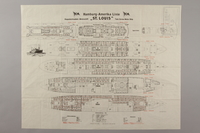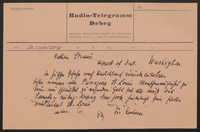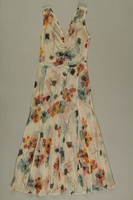Overview
- Brief Narrative
- Trio of drawings on one sheet of paper created by 11 year old Liesl Joseph in August 1939 shortly after arriving in England following the forced return of the MS St. Louis from Cuba. One drawing depicts the ocean liner; one marks each location the ship passed; one depicts the cottage lent to her family by the Rowntree family in England. Liesl and her parents, Josef and Lilly, left Germany soon after the Kristallnacht pogrom in November 1938. They left on the Hamburg-Amerika luxury liner, MS St. Louis, sailing for Havana on May 13, 1939. The plan was to wait there for permission to enter the US. But Cuban authorities denied entry to all but 28 of the 937 passengers. Josef chaired the passenger committee that tried to find a safe harbor. Liesl remembers feeling that "as long as my father was involved, we would be all right." After a week, the ship was ordered to leave. The US government refused to make any exception to the quota limits. The ship was forced to head back to Europe on June 6. Jewish aid organizations negotiated with European governments to admit the passengers rather than return them to Germany. The ship docked in Antwerp, Belgium, on June 17 and the Joseph family continued on to England. Joseph was interned as an enemy alien, but when they received US visas, the family departed on the Cameronia and arrived in the US on September 10, 1940.
- Artwork Title
- Journey of the M.S. St. Louis
- Date
-
creation:
1939 August
depiction: 1939 May 13-1939 August
- Geography
-
creation:
London (England)
depiction: St. Louis (Ship) route; Atlantic Ocean
- Credit Line
- United States Holocaust Memorial Museum Collection, Gift of Liesl Joseph Loeb
- Markings
- side with single picture of ship, lower center, multi-colored block letters in crayon : THE GERMAN SHIP / ST. LOUIS FROM: HABANA TO ANTWERP
side with single picture of ship, lower left corner, crayon : Liesl Joseph / LONDON / 11 years ENGL.
map of voyage, top center, handwritten : Journey of the M.S. St. Louis / redline to - greenline from Cuba
map of voyage, lower left, crayon : Liesl Joseph / Aug. 1939 - Signature
- front, lower left corner, crayon : Liesl Joseph / LONDON / 11 years ENGL / back, lower left corner, crayon : Liesl Joseph / Aug. 1939
- Contributor
-
Artist:
Liesl J. Loeb
Subject: Liesl J. Loeb
- Biography
-
Liesl Joseph was born in Rheydt, Germany, on June 17,1928, the only child of Josef, born November 9, 1882, in Altenbamberg, and Lilly Salmon Joseph, born April 25,1901, in Odenkirchen. Her father was a successful lawyer and a member of the Social Democratic Party (SPD.) The family was wealthy, with a twenty room house, servants, and a governess for Liesl. Following Hitler’s appointment as Chancellor in 1933, political opposition was violently suppressed. The SPD was one of the few political organizations that tried to resist Nazi rule. Josef was blacklisted for his membership in the SPD and barely escaped arrest. Civil rights for all citizens were soon abolished and antisemitic policies became increasingly punitive. Gentile friends stopped associating with them, and Liesl had stones thrown at her as she walked to school. During Kristallnacht, November 9, 1938, Josef was arrested. The next night, a mob broke into their home; Lilly and Liesl hid with their non-Jewish tenants on the third floor. Everything was destroyed - the furnishings, all belongings, and the windows and doors were smashed. Lilly and Liesl left to live with Lilly’s relatives in Bonn. Josef was being held in a local jail and soon was released on the condition that he leave the country.
They purchased tickets for a trip aboard the Hamburg-America luxury liner, MS St. Louis, sailing to Havana, Cuba. They left Hamburg on May 13, 1939, and arrived in Cuba on May 27. Nearly all of the 937 passengers were Jewish refugees hoping to escape from Nazi dominated Europe. The plan was to wait in Cuba for permission to enter the US, but Cuban authorities denied entry to all but 28 passengers. Josef, skilled as a lawyer and negotiator, was asked to chair the passenger committee. Liesl remember feeling that “as long as my father was involved, we would be all right. He was busy telegraphing and communicating with the rest of the world trying to find a safe place for the passengers." The American Jewish Joint Distribution Committee negotiated with the Cuban president for refuge but, after a week, the ship was ordered to leave the harbor. Despite urgent pleas to the United States government, the US President and Congress chose not to make any special exceptions to the stiff US quota limits and the refugees were denied permission to enter the US. Captain Schroeder took the ship within sight of the Florida coast, before heading back to Europe on June 6. Jewish aid organizations had negotiated with four European governments, Belgium, Great Britain, France, and the Netherlands to admit the passengers rather than return them to Germany. The Joseph family disembarked in Antwerp, Belgium, on June 17, Liesl’s eleventh birthday. They then travelled to England with Morris Troper, the head of the Joint Distribution Committee, and his family on board the Rhakotis.
The Joseph family rented a one-room apartment in London. During the Blitz, the intensive bombing campaign on London by Germany, Liesl was sent to Clifton where she attended a Jewish secondary school and boarded with the Whittington. In August 1940, her father was interned on the Isle of Man as an enemy alien. When the bombing raids ended, Liesl returned to London to live with her mother.
In 1940, the family received US visas and departed on the Camaronia. They arrived in the US on September 10 and settled in Philadelphia where Lilly had relatives. Her mother worked as a maid and her father sold candy. In 1945, Josef learned that his sister and one of her two sons had been killed in a concentration camp. The members of Lilly’s family who had remained in Germany, including her mother and two sisters, also perished in the camps. Josef died, age 63 years, in November 1945. Liesl completed school, and in 1947, married Hans Joseph Loeb. They had a son and a daughter. Hans died in 1987. Liesl had a career as a graphic designer. She was a frequent speaker to community groups, dedicating herself to teaching others through her experiences of the Holocaust. Her mother, now Lilly Joseph Kamin, died, age 92 years, in November 1993. Liesl passed on August 25, 2013, age 85 years.
Physical Details
- Language
- English
- Classification
-
Art
- Category
-
Children's art
- Object Type
-
Children's drawings (lcsh)
- Physical Description
- Three drawings in pencil and colored wax crayon on a single sheet of paper. Two pictures are placed top to top on one side: on the bottom is an image of a brick cottage with a red roof, surrounded by a white picket fence, with a green lawn and a partial yellow sun shines in a blue sky. The top half depicts a map with the title handwritten in the top center. Two lines arch below the title indicating the beginning of the journey from Hamburg to Havana/Florida and the return trip to Antwerp; dates appear at intervals on the lines with small official paper ship flags attached to metal pins set into the paper at the same intervals as the dates. Below the line with flags is a large yellow ship's shield emblem with more flag pins stuck into the paper. The initials "H. A. P. A. G." are partially visible behind the flags on the shield; on either side of the shield is an anchor. The artist's signature and the date is inscribed in the lower left corner. On the reverse is a colored drawing of a large ship on waves with smoke stack and flag on either end. A picture is contained within 8-sided "window," in the upper right. There is handwritten English text in the lower left and in the center, text in multi-colored block letters.
- Dimensions
- overall: Height: 11.000 inches (27.94 cm) | Width: 7.125 inches (18.098 cm)
- Materials
- overall : paper, wax crayon, graphite, adhesive
Rights & Restrictions
- Conditions on Access
- No restrictions on access
- Conditions on Use
- No restrictions on use
Keywords & Subjects
- Topical Term
- Jewish children in the Holocaust--Germany--Biography. Jewish refugees--Great Britain--Biography. Jewish refugees--Philadelphia--Pennsylvania--Biography. Jews--Persecution--Germany--Biography.
- Geographic Name
- Cuba--Emigration and immigration--Government policy--Biography. Germany--Emigration and immigration--Biography. United States--Emigration and immigration--Government policy--Biography.
- Corporate Name
- St. Louis (Ship)
Administrative Notes
- Legal Status
- Permanent Collection
- Provenance
- The drawing was donated to the United States Holocaust Memorial Museum in 1991 by Liesl Joseph Loeb.
- Record last modified:
- 2023-06-02 09:16:24
- This page:
- https://collections.ushmm.org/search/catalog/irn4599
Download & Licensing
In-Person Research
- By Appointment
- Request 21 Days in Advance of Visit
- Plan a Research Visit
- Request to See This Object
Contact Us
Also in Liesl Joseph Loeb collection
The collection consists of an MS St. Louis ship plan, a child's drawing, an evening dress, correspondence, documents, photographs, and printed materials relating to the experiences of Joseph and Lily Joseph and their daughter Liesl before the Holocaust, when they left Germany on the MS St. Louis, their arrival in England, and their immigration to the United States.
Date: 1938-1993

MS St. Louis floor plan
Object
Original floor-plan for the ship, MS St. Louis acquired by Liesl Joseph and her family, who were passengers on the ill fated voyage of the ocean liner in the spring of 1939. Liesl, 11, and her parents, Josef and Lilly, left Germany soon after the Kristallnacht pogrom in November 1938. They departed on the Hamburg-Amerika luxury liner, MS St. Louis, sailing for Havana on May 13, 1939. The plan was to wait there for permission to enter the US. But Cuban authorities denied entry to all but 28 of the 937 passengers. Josef chaired the passenger committee that tried to find a safe harbor. Liesl remembers feeling that "as long as my father was involved, we would be all right." After a week, the ship was ordered to leave. The US government refused to make any exception to the quota limits. The ship was forced to head back to Europe on June 6. Jewish aid organizations negotiated with European governments to admit the passengers rather than return them to Germany. The ship docked in Antwerp, Belgium, on June 17 and the Joseph family continued on to England. Joseph was interned as an enemy alien, but when they received US visas, the family departed on the Cameronia and arrived in the US on September 10, 1940.

Liesl Joseph Loeb papers
Document
The Liesl Joseph Loeb papers consist of correspondence files, emigration and immigration files, MS St. Louis files, photographs, and printed materials documenting the Joseph family’s departure from Germany and voyage on the St. Louis, the Passenger Committee’s work to find refuge for the ship’s passengers, and the Joseph family’s arrival in England and immigration to the United States. Correspondence includes letters and postcard from Josef Josephs to his family while he was interned as an enemy alien as well as with fellow former passengers of the St. Louis, such as Herbert Manasse and Ernst Vendig, and with officials who tried to help passengers aboard the St. Louis, such as Morris C. Troper of the American Jewish Joint Distribution Committee. The correspondence describes conditions in the internment camp on the Isle of Man and documents the Josephs efforts to immigrate to the United States, obtain reimbursement for the Cuban landing permits that were denied by the Cuban government, and recovery of belongings shipped to Cuba. This series also includes Josef Joseph’s open letter to Joseph Goebbels as well as an appeal to the German Jewish immigrant community in the United States to establish a fund to aid orphaned and displaced children that Aufbau declined to publish. A handful of the correspondence in this series consists of photocopies or transcriptions from the 1990s. Emigration and immigration files include German documents clearing the Josephs family for emigration and listing the possession they intended to take, correspondence documenting the Josephs’ arrangements for Cuban transit visas and travel to Cuba aboard the St. Louis, messages from the American Consulate General in London regarding the Josephs’ plans to immigrate to the United States, and two records indicating the Josephs’ considered emigrating to the Dominican Republic. MS St. Louis records primarily consist of announcements, reports, and telegrams. The telegrams documenting communications between the Passenger Committee and organizations including the American Jewish Joint Distribution Committee, Hamburg‐America Passagierlinie, A.G. (HAPAG), the German‐Jewish Aid Association (Hilfsverein), and Hias‐Ica‐Emigration Association (HICEM), the American and British governments, and the press as the Passenger Committee and Captain Schroeder tried to negotiate a safe haven for the ship’s passengers. The announcements and reports document efforts by the Passenger Committee, Captain Schroeder, and the ship’s crew to keep the passengers informed of developments. This series also includes Cuban immigrant identification cards for the Josephs family, an excerpt from Josef Joseph’s diary describing the journey, and a copy of the ship’s passenger list. Photographs depict the Josephs family, Fritz Buff, Edie Babich, and Ilse, Karl, and Selma Simon aboard the St. Louis. Printed materials include British, German, Swiss, and Dutch newspaper clippings documenting the St. Louis’ return to Europe, a newspaper clipping containing Josef Joseph’s thanks to those who helped the St. Louis passengers find temporary refuge, and an informational brochure for refugees in England.

Floral evening dress with purple slip worn to the Celebration Ball on the ill-fated voyage of the MS St. Louis
Object
Evening gown worn by Lilly Joseph on board the MS St. Louis for the Celebration and Ball on June 13, 1939. She had the gown made for the voyage, and she wore it only once, for the Celebration held the evening the passengers learned that they did not have to return to Nazi Germany. During the Kristallnacht pogrom, November 9-10, 1938, vandals broke into the Joseph home in Rheydt, Germany. Lilly and her 10 year old daughter, Liesl, hid on the third floor and her husband Joseph was arrested. He was released on the condition that he leave the country. The family sailed on the Hamburg-Amerika luxury liner, Ms St. Louis, for Havana, Cuba, on May 13, 1939. The plan was to wait in Cuba for permission to enter the US. Cuban authorities declared most permits invalid and denied entry to all but 28 of the 937 passengers. Josef chaired the passenger committee during the search for a safe haven. After a week, the ship was ordered to leave Havana. Despite urgent pleas to the US, no exceptions were made to the quota limits and the refugees were denied permission to enter the US. The ship had to head back to Europe on June 6. Jewish aid organizations negotiated with European governments to admit the passengers rather than return them to Nazi Germany. The ship docked in Antwerp, Belgium, on June 17 and the Joseph family continued on to England. Josef was imprisoned as an enemy alien, but the family received US visas and arrived in NY on September 10, 1940.



